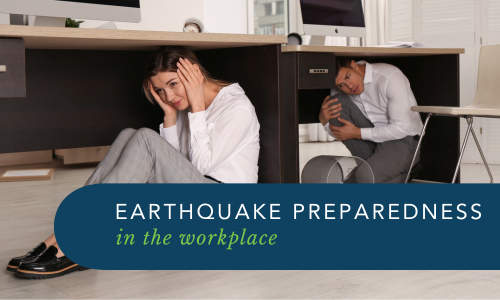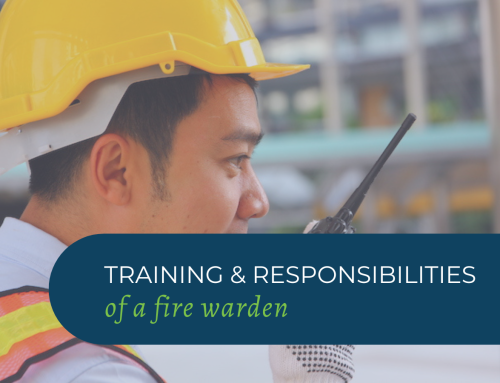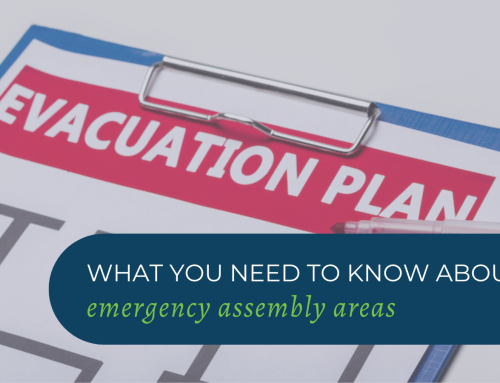During an earthquake, your primary goal is to protect yourself from injury and ensure the safety of those around you. While earthquakes are sudden and unsettling, knowing the right steps to take can make a decisive difference in how well you respond. Your workplace & the type of work that takes place there, will also factor into your emergency response. Here’s what to do:
- Drop, Cover, and Hold On
As soon as the shaking begins, immediately drop to your hands and knees to prevent being knocked over & if possible, take shelter under a sturdy desk or table. If there’s no shelter nearby, cover your head and neck using your arms to shield your head & protect it from falling debris. Finally, hold on to your shelter if you’ve found one, as aftershocks or continuing tremors may follow the initial shake.
- Hazardous Areas
Factories can be dangerous during an earthquake as they house hazardous materials, heavy machinery, or equipment. Spaces with high shelves or overhead storage are at risk of objects falling. Make sure you position yourself away from these hazards. If there is no immediate cover, try to protect your head and neck using your arms. If possible, crouch down to minimize your exposure to falling items.
If you are near machinery, power tools, or large equipment, try to move away from them to avoid being trapped by falling objects or malfunctioning equipment. Avoid areas with flammable substances, electrical panels, or high-voltage equipment, as these can present significant fire or electrical hazards if damaged during the quake.
- Stay Indoors
It’s important to stay inside during the shaking. Exiting the building during an earthquake puts you at risk of falling debris, broken glass, or structural collapse. Don’t attempt to run outside or use elevators. Elevators are especially dangerous because they can become stuck, and power outages can leave you trapped.
- Stay Away from Windows and Heavy Objects
Avoid areas with large windows, glass doors, or tall, heavy furniture that might tip over. Glass can shatter during an earthquake, and heavy objects can fall or slide, causing injury. Position yourself under desks or against interior load bearing walls away from these hazards.
- Don’t Block Exits
Even though you need to protect yourself during the shaking, avoid blocking exits, stairwells, or doorways. After the shaking stops, it’s important to be able to evacuate quickly and safely, especially if the building has sustained damage.
- Wait for the Shaking to Stop
Earthquakes can last anywhere from a few seconds to a minute or more. During this time, don’t move until the shaking stops completely. Once the shaking subsides, evaluate your surroundings. If the building seems safe, prepare for an evacuation. If structural damage is visible, such as cracks in walls or the ceiling, do not attempt to leave through those areas. Use the nearest exit and avoid elevators.
In many cases, aftershocks will follow the initial quake, so remain alert.
- Check for Injuries and Hazards
After the shaking has stopped, assess your surroundings. Check yourself and your colleagues for injuries and apply first aid if needed. Inspect the area for hazards such as gas leaks, fires, or structural damage that could make it unsafe to remain inside. If there are any signs of fire, smoke, or a gas leak, evacuate the area immediately.
- Listen for Emergency Announcements & Evacuate Safely if Necessary
In modern office buildings, emergency alarms or PA systems are typically used to inform occupants of evacuation procedures. Listen for instructions from building management or local authorities. If the building is deemed unsafe, evacuate calmly and quickly, using stairs rather than elevators.
If evacuation is necessary, use designated exit routes, but avoid using elevators. If the building has sustained damage, move quickly but cautiously to the nearest safe exit. Avoid walking near windows, large glass areas, or any exposed electrical equipment. Stay calm and avoid pushing or shoving as you exit.
If you do evacuate the building, remain cautious and aware of hazard external to the building such as, downed power lines, gas line ruptures and holes in the ground. Be guided by your ECO.
- Follow Emergency Procedures
Factory environments typically have specific emergency procedures in place. Follow these instructions, whether that involves assembling at a designated safe area or awaiting further instructions from supervisors or local emergency authorities. Make sure all workers are accounted for before re-entering the workplace.
- Be Prepared for Aftershocks
Earthquakes are often followed by aftershocks. These can be smaller in magnitude but still strong enough to cause damage or injury. After evacuating, stay away from buildings, power lines, or other potential hazards.
Being prepared and knowing how to respond during an earthquake can make all the difference in keeping people safe. Workplaces such as multi-storey buildings, office towers, and factories face added risks due to heavy machinery, hazardous materials, and complex layouts.
Regular training and emergency drills help ensure everyone understands their role and can act quickly when it matters most. By staying calm, following safety procedures, and maintaining awareness, workplaces can greatly reduce the risk of injury and support a safer outcome for all.
GET IN TOUCH
Are you ready for peace of mind that your workforce is as safe and prepared as possible?
With a dedicated team of staff ready to help you meet compliance requirements and improve the overall safety of your workplace, all you need to do is get in touch.
Request your free audit today!



